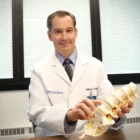If you were recently diagnosed with trigeminal neuralgia and started on medication, you probably had high hopes that it would eliminate your symptoms get you back to living your life. If you have found that medication is not a good option for you, you’re not alone. Many people deal with the disappointment and worry that comes with trigeminal neuralgia medication failures. On the positive side, new treatments for trigeminal neuralgia may provide you with the relief you’ve been seeking.
What Is Trigeminal Neuralgia?
Trigeminal neuralgia is a neurological condition in which the trigeminal nerve (the nerve that controls facial sensation) is damaged or compressed by a nearby blood vessel. This damage or compression (impingement) causes stabbing, electric shock-like pain on one side of your face. Some people experience these sensations intermittently throughout the day while others may experience them occasionally. The pain can be brought on or exacerbated by simple stimulation such as brushing your teeth or touching the side of your face.
Medications Used for Trigeminal Neuralgia
If you’ve been prescribed medications for your trigeminal neuralgia, it’s likely you were given either Tegretol or Trileptal. These are the two most effective medications used in the treatment of trigeminal neuralgia symptoms. They are both anti-convulsants, meaning they work on the nerves instead of just masking the pain. Unfortunately, some people experience side effects that are unbearable, making the medication a non-viable option for treatment. In other instances, Tegretol or Trileptal may not provide adequate relief from trigeminal neuralgia symptoms.
If you are not finding your medications to be working satisfactorily, it might be time to explore newer trigeminal neuralgia treatment options.
Microvascular Decompression as a Trigeminal Neuralgia Treatment Option
Microvascular decompression (MVD) surgery has become the suggested treatment for trigeminal neuralgia that is the result of an impingement on the next be by a blood vessel. It’s considered microsurgery, meaning it requires a much smaller incision, surgical site and instruments to perform. It also means there is a shorter recovery time than other intracranial procedures.
Using a small incision and removing a quarter-sized piece of bone tissue at the base of your skull, your surgeon will use a surgical microscope to isolate the trigeminal nerve and the artery or vein pressing against it. He or she will then carefully lift the blood vessel and place a tiny Teflon sponge between the two. This creates a cushion that will protect your trigeminal nerve from the pulsing of the vessel that is causing the irritation. Because no changes are made to the nerve, complete sensation and function are preserved.
There are a few things that will determine whether you’re a good candidate for MVD surgery. These include your health status and the cause of your trigeminal neuralgia. This surgery is recommended for young, healthy individuals. You must have a FIESTA MRI performed to determine whether or not your trigeminal neuralgia is the result of a blood vessel creating an impingement on your trigeminal nerve. If you fall under both of these qualifications then you are likely a good candidate for MVD surgery.
Are you out of options
to eliminate your pain?
Considering Gamma Knife Radiosurgery
Despite its name, Gamma Knife Radiosurgery (GKRS) isn’t surgery at all. The origin of its name stems from the precision with which it can be used to treat areas within your head and base of your skull.
GKRS is a non-invasive treatment that uses 200 or so tiny beams of radiation that enter the body separately and then converge on a very precise target. Because each beam is not highly concentrated, it does not cause tissue damage as it enters your body. It causes minor damage to the offending portion of the nerve, gradually relieving the pain as the offending nerve impulses become disrupted.
Due to its non-invasive nature and the fact that anesthesia isn’t required, Gamma Knife Radiosurgery is a great option if you can’t withstand surgery or would prefer not to undergo a surgical procedure.
Other Treatment Options for Trigeminal Neuralgia
If neither of the above options seems like a good fit for your trigeminal neuralgia treatment, there are still other possibilities that can deliver the relief you’re seeking.
Percutaneous rhizotomy is a procedure that uses light sedation and local anesthetics to perform the procedure. A thin needle is guided to the offending branches of your trigeminal nerve and heat, balloon compression or glycerol injections are used to cause enough damage to the nerve to interrupt the pain-causing impulses.
Pain stimulator placement is also used to treat trigeminal neuralgia. This procedure utilizes tiny electrodes that are threaded beneath your skin to your trigeminal nerve branches. These electrodes are then connected to a stimulator that sends out mild electrical pulses that disrupt the painful impulses produced by the trigeminal nerve. A trial run will be done with an external stimulator — once it’s determined this is a good treatment fit for you and your trigeminal neuralgia, a permanent stimulator will be installed just under your skin.
Trigeminal neuralgia can be a devastating condition but doesn’t have to rule your life. Even if medications aren’t the right answer for your TGN treatment, there are numerous options that will allow you to find the relief you’ve been searching for.

About Dr. Anthony D'Ambrosio
Dr. Anthony D'Ambrosio is an accomplished neurosurgeon in North Jersey and a proud member of Neurosurgeons of New Jersey practicing primarily out of their Ridgewood office conveniently located on East Ridgewood Avenue. Dr. D’Ambrosio focuses his clinical practice on brain tumors, nervous system disorders, and facial pain disorders. He has expertise in a variety of complex surgical and radiosurgical techniques as well as minimally invasive procedures intended to successfully treat complex diseases of the brain. These techniques include micro-neurosurgery, microvascular decompression surgery and Gamma Knife radiosurgery. He's authored over 25 peer-reviewed journals and is the recipient of many awards.






